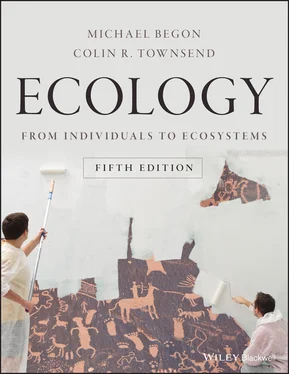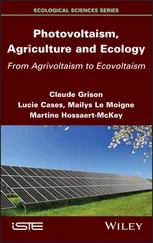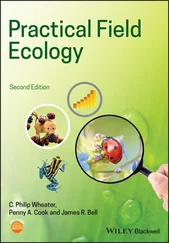Source : After Watkinson (1984).
constant yield and modularity
The constancy of the final yield is a result, to a large extent, of the modularity of plants. This was clear when perennial rye grass ( Lolium perenne ) was sown at a 30‐fold range of densities ( Figure 5.8). After 180 days some genets had died, but the range of final tiller (module) densities was far narrower than that of genets (individuals). The constancy arose largely through effects on the number of modules per genet rather than the number of genets themselves.

Figure 5.8 Intraspecific competition in plants often regulates the number of modules.When populations of rye grass ( Lolium perenne ) were sown at a range of densities, the range of final tiller (i.e. module) densities was far narrower than that of genets.
Source : After Kays & Harper (1974).
APPLICATION 5.1 Optimal sowing rates for conservation
The general tendency for final yield to saturate – not continue to increase in line with initial density – is something that underlies many activities throughout agriculture, horticulture and even animal husbandry. Generally, we wish to avoid investing unnecessarily in high stocking rates that will not translate ultimately into higher yields. A more unusual example of its application, though, is provided by a study seeking to conserve three species of plant facing extinction in large parts of Europe that may also sometimes be weeds, reducing the productivity of crops with which they may coexist (Lang et al ., 2016). The species concerned were European Venus’ looking glass, Legousia speculum‐veneris , forking larkspur, Consolida regalis , and field gromwell, Lithospermum arvense , which can all act as weeds in fields of winter rye, Secale cereale . How might we combine the conservation of these species with avoidance of crop loss? It is clear in Figure 5.9a that as the sowing densities of the plants was increased, significant levelling off was apparent at sowing densities above a few hundreds per square metre (though a strictly ‘constant’ yield was not reached). We can also see that below these kinds of levels, the yield of the rye was not affected ( Figure 5.9b), whereas with further increases in weed seed density, crop yield showed a significant drop (though at densities above around 1000 weed seeds per square metre it again levelled off). We will not discuss inter specific competition, between the weeds and the crop, in detail until Chapter 8. Nonetheless, we can understand that very low sowing rates of the three plants would be ineffective in establishing viable populations of these threatened species. However, a levelling off of the yield of new seeds was well underway before sowing densities were reached that affected crop yield. Lang and her co‐workers were therefore able to recommend ‘optimal’ sowing rates of 100 seeds per m 2for C. regalis and L. arvense and 50 seeds per m 2for L. speculum‐veneris , combining successful establishment, the avoidance of wasted seeds, and negligible crop loss.
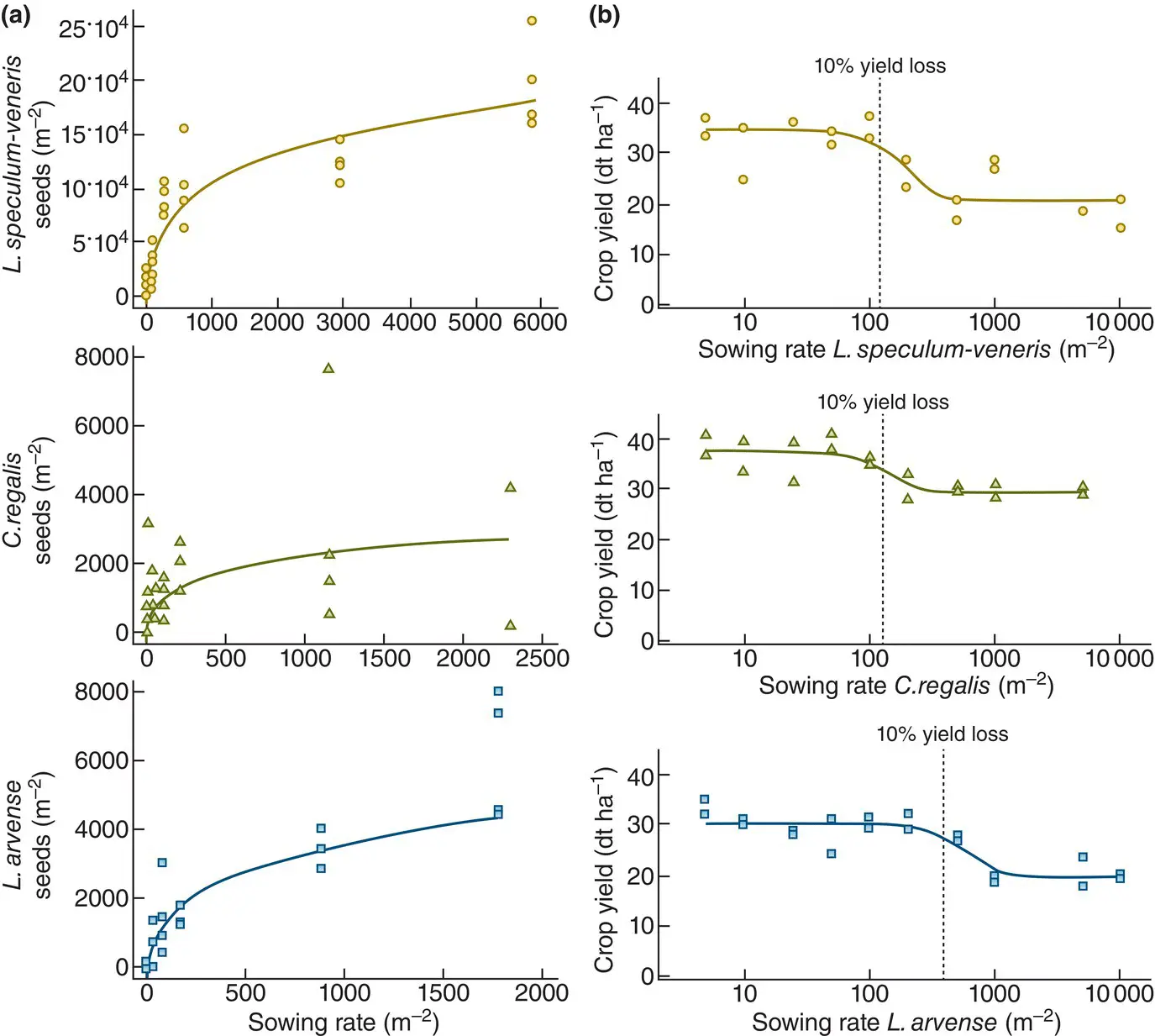
Figure 5.9 Optimal sowing rates can conserve rare weedy plants without threatening crop yields.(a) In experimental plots near Munich, Germany, seeds of three plant species, Legousia speculum‐veneris (top), Consolida regalis (middle) and Lithospermum arvense (bottom), were sown at a range of densities amongst a growing crop plant, rye, Secale cereale , and the yield of seeds of the three plants monitored at the end of the growing season. (b) Results for the same plots in terms of the biomass yield of the rye (dry tons per hectare).
Source : After Lang et al . (2016).
5.2.3 Density or crowding?
Of course, the intensity of intraspecific competition experienced by an individual is not really determined by the density of the population as a whole. The effect on an individual is determined, rather, by the extent to which it is crowded or inhibited by its immediate neighbours. Even in a population of mobile animals, individuals are unlikely to move around enough to interact with every other member of the population.
three meanings of density
One way of emphasising this is by noting that there’s more than one meaning of ‘density’ (see Lewontin & Levins, 1989 , where details of calculations and terms can be found). Consider a population of insects, distributed over a population of plants (patches of resource) on which they feed. The density would usually be calculated simply as the number of insects (let us say 1000) divided by the number of plants (say 100), i.e. 10 insects per plant. However, this is actually the ‘resource‐weighted density’, but it only gives an accurate measure of the intensity of competition suffered by the insects (the extent to which they are crowded) if there are exactly 10 insects on every plant.
Suppose, instead, that 10 of the plants support 91 insects each, and the remaining 90 support just one insect. The resource‐weighted density would still be 10 insects per plant. But to determine average density experienced by the insects, we note that 910 of them experienced a density of 91 insects per plant and 90 experienced just one per plant, giving us an overall average of 82.9 insects per plant (910 × 91, plus 90 × 1, divided by 1000) This is the ‘organism‐weighted density’, and it clearly gives a much more satisfactory measure of the intensity of competition the insects are likely to suffer. Clearly, the normal practice of calculating the resource‐weighted density and calling it ‘the density’ can be misleading.
neighbours
The difficulties of relying on density to characterise the potential intensity of intraspecific competition are particularly acute with sessile, modular organisms, because, being sessile, they compete almost entirely only with their immediate neighbours, and being modular, competition is directed most at the modules that are closest to those neighbours. We can see this, for example, when seedlings of three species of fir tree, Douglas fir ( Pseudotsuga menziesii ), grand fir ( Abies grandis ) and noble fir ( A. procera ), were grown together in conspecific pairs or grown alone. In all three, after two years, the diameter growth of branches facing their competitor was significantly reduced in trees grown in pairs compared with the growth of branches of trees grown alone ( Figure 5.10a). But these effects of competition were expressed almost entirely by those branches facing their neighbour ( Figure 5.10b). Those on the other side of the tree had growth rates similar to those of the isolated plants. The individual plants, and their component modules, were affected by the proximity of their competitors rather than density per se .
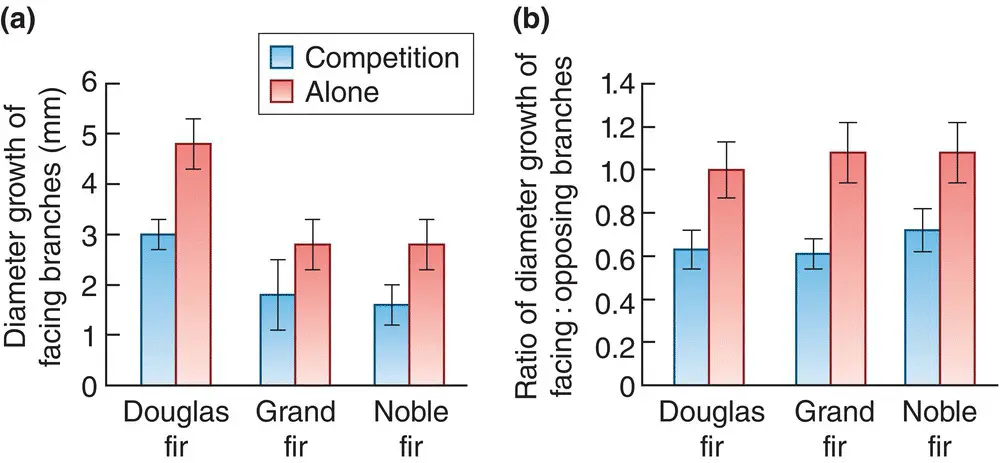
Figure 5.10 When modular organisms compete, the modules closest to neighbours are the most affected.(a) The growth of ‘facing’ branches of three species of fir tree after two years of growth either in pairs (where the branches faced the competitor) or in isolation (where ‘facing’ branches grew in the same direction but with no competitor). (b) The ratio of the growth of facing branches (from (a)) to ‘opposing’ branches on the opposite side of the tree seedlings. In isolation, the ratios were not significantly different from 1; but in competition, the ratios indicate that the growth of opposing branches was similar to that of all branches in the isolated plants. Bars are 95% CIs.
Читать дальше
